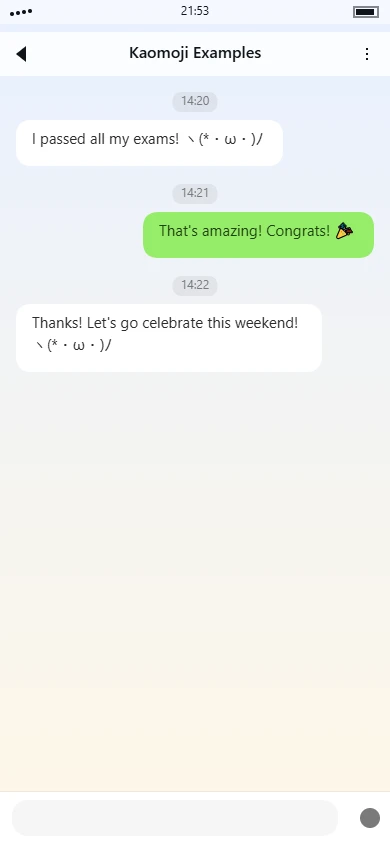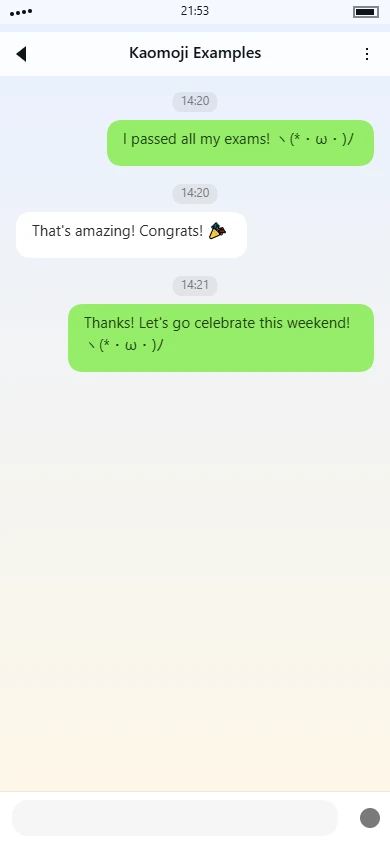(⌒ω⌒) kaomoji | kahulugan, paggamit

Overview
The kaomoji
(⌒ω⌒)Symbol Breakdown
- Parentheses
(
: These symbols form the outer boundary of the face, creating a rounded contour that suggests a soft, friendly appearance. The parentheses help contain the expression within a recognizable facial structure.) - Upper curve
: This character represents the eyes in a closed, smiling position. The curved shape gives the impression of eyes that are gently shut due to happiness, similar to how people squint when genuinely smiling. The use of this specific curved character instead of simple dots or lines adds a distinctive stylistic element.⌒ - Greek letter omega
: Positioned between the eyes, this character serves as the mouth. Its wavy, rounded shape suggests a small, content smile rather than an exaggerated grin. The omega character's flowing curves complement the eye symbols above it, creating visual harmony in the overall composition.ω
Emotion & Aesthetic Analysis
The emotional tone conveyed by
(⌒ω⌒)Visually, the kaomoji exhibits a balanced symmetry with the eyes positioned at equal height and the mouth centered between them. The consistent use of curved lines throughout the composition - in the eyes, mouth, and facial outline - creates a cohesive aesthetic that feels soft and approachable. The overall effect is somewhat reminiscent of a contented cat's expression, which contributes to its occasional association with feline-like contentment in online communication.
In practical usage, this kaomoji appears in contexts where someone wants to express gentle approval, quiet happiness, or satisfied agreement. It might follow a statement of personal contentment, accompany a positive reaction to someone else's message, or serve as a friendly acknowledgment. The expression's restrained nature makes it suitable for situations where more exuberant emoticons might feel excessive, providing a middle ground between neutral and highly enthusiastic responses.
When compared to similar kaomoji,
(⌒ω⌒)(^_^)Tag categories
Use tags to quickly understand this kaomoji.
Emotion tags
Expression tags
Click tags to explore related kaomoji.
Usage guide
Gabay sa Paggamit ng (⌒ω⌒)
Ang kaomoji na (⌒ω⌒) ay isa sa mga pinaka-maraming gamit at malawakang ginagamit na Japanese-style emoticon sa online na komunikasyon, na kumakatawan sa isang kuntento at masayang mukha na nakapikit ang mga mata at may banayad na ngiti. Ang emoticon na ito ay nagpapahiwatig ng pakiramdam ng mapayapang kasiyahan, mainit na pagmamahal, o tahimik na kasiyahan—parang isang taong nag-eenjoy sa isang kaaya-ayang sandali. Ang nakapikit nitong mga mata ay nagpapahiwatig ng pakiramdam ng ginhawa at relax, kaya perpekto ito para ipahayag ang pasasalamat, magbahagi ng maliliit na kasiyahan, o simpleng magdagdag ng init sa mga casual na usapan. Madalas mo itong makikita sa mga usapan ng magkakaibigan, sa gaming chats, sa mga social media post, at sa mga komento kung saan kailangan ng magaan at positibong tono.
Mga Paggamit
- Pagpapadala ng pasasalamat sa kaibigan na tumulong sa iyo sa isang gawain
- Pag-react sa isang cute na larawan ng alagang hayop na ibinahagi sa group chat
- Pagpapahayag ng kasiyahan pagkatapos makumpleto ang isang mahirap na level sa video game
- Pagkokomento sa isang relaxing na music track o ambient sound video
- Pagsagot sa mabuting balita mula sa isang kapamilya sa private message
- Pagpapakita ng pagpapahalaga sa isang masarap na pagkain na larawan sa social media
- Pagkilala sa isang maalalahanin na kilos mula sa katrabaho sa isang casual na work chat
- Pag-react sa mga nakakagaan ng puso na kwento o positibong update sa online communities
- Pagpapahayag ng kasiyahan habang ibinabahagi ang iyong sariling relaxing weekend plans
- Pagdaragdag ng init sa isang birthday wish o holiday greeting
- Pagpapakita ng banayad na kasiyahan sa isang matalinong ngunit harmless na biro
- Pagpapahiwatig ng mapayapang kasiyahan kapag pinag-uusapan ang mga paboritong hobby
Mga Halimbawa
-
Usapan ng magkaibigan tungkol sa mga plano Tao A: "Nabook ko na ang mga concert ticket na gusto natin!" Tao B: "Ang galing naman! Excited na ako (⌒ω⌒)"
-
Chat sa gaming community Player A: "Nakuha ko na ang rare achievement pagkatapos ng 50 tries" Player B: "Congrats! Sulit ang dedication mo (⌒ω⌒)"
-
Komento sa social media Post: "Ginugol ko ang hapon sa pagbabasa sa park kasama ang aso ko" Komento: "Parang perpektong araw iyan (⌒ω⌒)"
-
Casual na mensahe sa trabaho Katrabaho: "Nagdala ako ng extra na kape para sa team kaninang umaga" Ikaw: "Ang bait mo naman, salamat! (⌒ω⌒)"
-
Family group chat Kamag-anak: "Ginawa ko ang paborito mong cookies, itatabi ko para sa pagbisita mo" Ikaw: "Ang bait mo talaga! Excited na ako (⌒ω⌒)"
-
Discussion sa online forum User A: "Ang smooth na ng interface dahil sa bagong update na ito" User B: "Napansin ko rin iyan, mas maganda na ang pakiramdam ng lahat ngayon (⌒ω⌒)"
Mga Paalala
- Iwasang gamitin ang kaomoji na ito sa mga formal na business email, opisyal na komunikasyon, o seryosong talakayan kung saan kailangan ang propesyonal na tono—maaari itong magmukhang masyadong casual o immature
- Bagama't karaniwang positibo, ang nakapikit na mga mata ay maaaring minsang ma-misinterpret bilang pagmamataas o sobrang kasiyahan sa sarili sa ilang konteksto, kaya isipin ang iyong relasyon sa tatanggap
- Ang emoticon na ito ay pinakamainam sa one-on-one na usapan o maliliit na group chat kaysa sa malalaking propesyonal na meeting o anunsyo
- Ang tono ay karaniwang mainit at banayad sa halip na excited o masigla—mas nakatuon ito sa tahimik na kasiyahan kaysa sa maingay na pagdiriwang
- Cultural note: Ang istilong ito ng kaomoji ay nagmula sa mga Japanese online communities at nananatiling partikular na popular sa anime, gaming, at tech circles, bagama't malawak itong naiintindihan sa global internet culture
- Platform variation: Sa Twitter at Discord, madalas mo itong makikita sa mga fandom spaces at gaming communities, habang sa Instagram maaari itong lumabas sa mga komento sa cozy o aesthetic na content
Tandaan na ang pinakamainam na paggamit ng (⌒ω⌒) ay nagmumula sa pagtutugma ng banayad at kuntentong enerhiya nito sa mga angkop na sitwasyon kung saan gusto mong magpadala ng init nang walang sobrang excitement.
Usage examples
Real conversation samples that feature this kaomoji.

Example 1

Example 2
Related kaomoji
You might also enjoy these kaomoji.